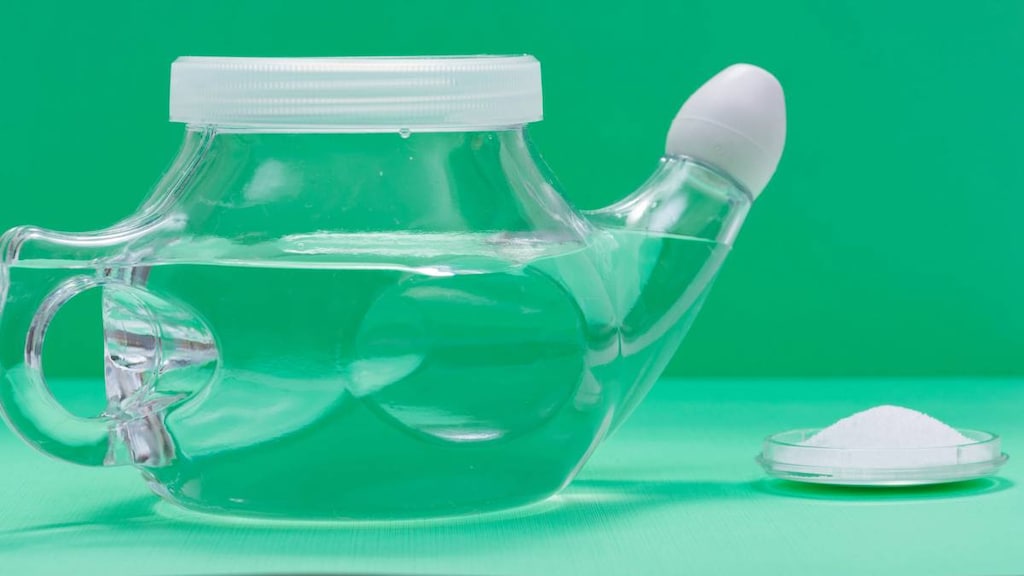Dosage Forms
Excipient information presented when available (limited, particularly for generics); consult specific product labeling.
Solution, Nasal, as hydrochloride:
Adrenalin: 0.1% (30 mL)
Pharmacology
Mechanism of Action
Stimulates alpha-, beta1-, and beta2-adrenergic receptors resulting in local vasoconstriction and relief of nasal congestion
Pharmacokinetics/Pharmacodynamics
Metabolism
Taken up into the adrenergic neuron and metabolized by monoamine oxidase and catechol-o-methyltransferase; circulating drug hepatically metabolized
Excretion
Urine (as inactive metabolites, metanephrine, and sulfate and hydroxy derivatives of mandelic acid; small amounts as unchanged drug)
Onset of Action
Local vasoconstriction (topical): 5 minutes
Duration of Action
Local vasoconstriction (topical): <1 hour
Use: Labeled Indications
Treatment of nasal congestion
Dosage and Administration
Dosing: Adult
Decongestant: Intranasal: Apply 1 mg/mL solution locally as drops or spray or with sterile swab
Dosing: Geriatric
Refer to adult dosing.
Dosing: Pediatric
Nasal congestion: Children ≥6 years and Adolescents: Intranasal: 1 mg/mL topical solution: Apply locally as drops or spray or with sterile swab; may also further dilute prior to application; consult product specific labeling
Administration
May be diluted with isotonic saline for a less concentrated solution.
Storage
Epinephrine is sensitive to light and air. Protection from light is recommended. Oxidation turns drug pink, then a brown color. Solutions should not be used if they are discolored or contain a precipitate.
Drug Interactions
Alpha1-Blockers: May diminish the vasoconstricting effect of Alpha-/Beta-Agonists. Similarly, Alpha-/Beta-Agonists may antagonize Alpha1-Blocker vasodilation. Monitor therapy
AtoMOXetine: May enhance the hypertensive effect of Sympathomimetics. AtoMOXetine may enhance the tachycardic effect of Sympathomimetics. Monitor therapy
Beta-Blockers (Beta1 Selective): May diminish the therapeutic effect of EPINEPHrine (Nasal). Monitor therapy
Beta-Blockers (Nonselective): May enhance the hypertensive effect of EPINEPHrine (Nasal). Exceptions: Arotinolol; Carvedilol; Labetalol. Monitor therapy
Beta-Blockers (with Alpha-Blocking Properties): May diminish the therapeutic effect of EPINEPHrine (Nasal). Monitor therapy
Cannabinoid-Containing Products: May enhance the tachycardic effect of Sympathomimetics. Exceptions: Cannabidiol. Monitor therapy
Chloroprocaine: May enhance the hypertensive effect of Alpha-/Beta-Agonists. Monitor therapy
Cocaine (Topical): May enhance the hypertensive effect of Sympathomimetics. Management: Consider alternatives to use of this combination when possible. Monitor closely for substantially increased blood pressure or heart rate and for any evidence of myocardial ischemia with concurrent use. Consider therapy modification
COMT Inhibitors: May decrease the metabolism of COMT Substrates. Monitor therapy
Doxofylline: Sympathomimetics may enhance the adverse/toxic effect of Doxofylline. Monitor therapy
Ergot Derivatives: May enhance the hypertensive effect of Alpha-/Beta-Agonists. Ergot Derivatives may enhance the vasoconstricting effect of Alpha-/Beta-Agonists. Exceptions: Ergoloid Mesylates; Nicergoline. Avoid combination
Guanethidine: May enhance the arrhythmogenic effect of Sympathomimetics. Guanethidine may enhance the hypertensive effect of Sympathomimetics. Monitor therapy
Inhalational Anesthetics: May enhance the arrhythmogenic effect of EPINEPHrine (Nasal). Monitor therapy
Linezolid: May enhance the hypertensive effect of Sympathomimetics. Management: Reduce initial doses of sympathomimetic agents, and closely monitor for enhanced pressor response, in patients receiving linezolid. Specific dose adjustment recommendations are not presently available. Consider therapy modification
Monoamine Oxidase Inhibitors: May enhance the hypertensive effect of EPINEPHrine (Nasal). Monitor therapy
Promethazine: May diminish the vasoconstricting effect of EPINEPHrine (Nasal). Monitor therapy
Serotonin/Norepinephrine Reuptake Inhibitors: May enhance the tachycardic effect of Alpha-/Beta-Agonists. Serotonin/Norepinephrine Reuptake Inhibitors may enhance the vasopressor effect of Alpha-/Beta-Agonists. Consider therapy modification
Solriamfetol: Sympathomimetics may enhance the hypertensive effect of Solriamfetol. Monitor therapy
Spironolactone: May diminish the vasoconstricting effect of Alpha-/Beta-Agonists. Monitor therapy
Sympathomimetics: May enhance the adverse/toxic effect of other Sympathomimetics. Monitor therapy
Tedizolid: May enhance the hypertensive effect of Sympathomimetics. Tedizolid may enhance the tachycardic effect of Sympathomimetics. Monitor therapy
Tricyclic Antidepressants: May enhance the vasopressor effect of Alpha-/Beta-Agonists. Management: Avoid, if possible, the use of alpha-/beta-agonists in patients receiving tricyclic antidepressants. If combined, monitor for evidence of increased pressor effects and consider reductions in initial dosages of the alpha-/beta-agonist. Consider therapy modification
Adverse Reactions
Frequency not defined.
Cardiovascular: Angina pectoris, cardiac arrhythmia, chest pain, flushing, hypertension, palpitations, tachycardia (parenteral administration), vasoconstriction, ventricular ectopy
Central nervous system: Anxiety (transient), apprehension, cerebral hemorrhage, dizziness, headache, insomnia, nervousness, restlessness
Dermatologic: Diaphoresis, pallor
Gastrointestinal: Anorexia, nausea, vomiting, xerostomia
Genitourinary: Acute urinary retention (patients with bladder outflow obstruction)
Hypersensitivity: Hypersensitivity reaction (eyelid)
Neuromuscular & skeletal: Tremor, weakness
Ophthalmic: Angle-closure glaucoma (precipitation or exacerbation), burning sensation of eyes, eye irritation, eye pain, stinging of eyes (transient)
Respiratory: Dry throat, dyspnea, pulmonary edema
Warnings/Precautions
Disease-related concerns:
- Cardiovascular disease: Use with caution in patients with cardiovascular diseases (eg, coronary artery disease, hypertension).
- Cerebrovascular disease: Use with caution in patients with cerebrovascular disease.
- Diabetes: Use with caution in patients with diabetes mellitus; may transiently increase blood glucose levels.
- Parkinson's disease: Use with caution in patients with Parkinson's disease; may cause temporary worsening of symptoms.
- Thyroid disease: Use with caution in patients with thyroid disease.
Concurrent drug therapy issues:
- Tricyclic antidepressants: Use with caution in patients taking tricyclic antidepressants; effects of epinephrine may be potentiated.
Special populations:
- Elderly: Use with caution in the elderly.
Pregnancy
Pregnancy Considerations
Refer to the EPINEPHrine (Systemic) monograph.
Patient Education
- Discuss specific use of drug and side effects with patient as it relates to treatment. (HCAHPS: During this hospital stay, were you given any medicine that you had not taken before? Before giving you any new medicine, how often did hospital staff tell you what the medicine was for? How often did hospital staff describe possible side effects in a way you could understand?)
- Educate patient about signs of a significant reaction (eg, wheezing; chest tightness; fever; itching; bad cough; blue skin color; seizures; or swelling of face, lips, tongue, or throat). Note: This is not a comprehensive list of all side effects. Patient should consult prescriber for additional questions.
Intended Use and Disclaimer: Should not be printed and given to patients. This information is intended to serve as a concise initial reference for health care professionals to use when discussing medications with a patient. You must ultimately rely on your own discretion, experience, and judgment in diagnosing, treating, and advising patients.

